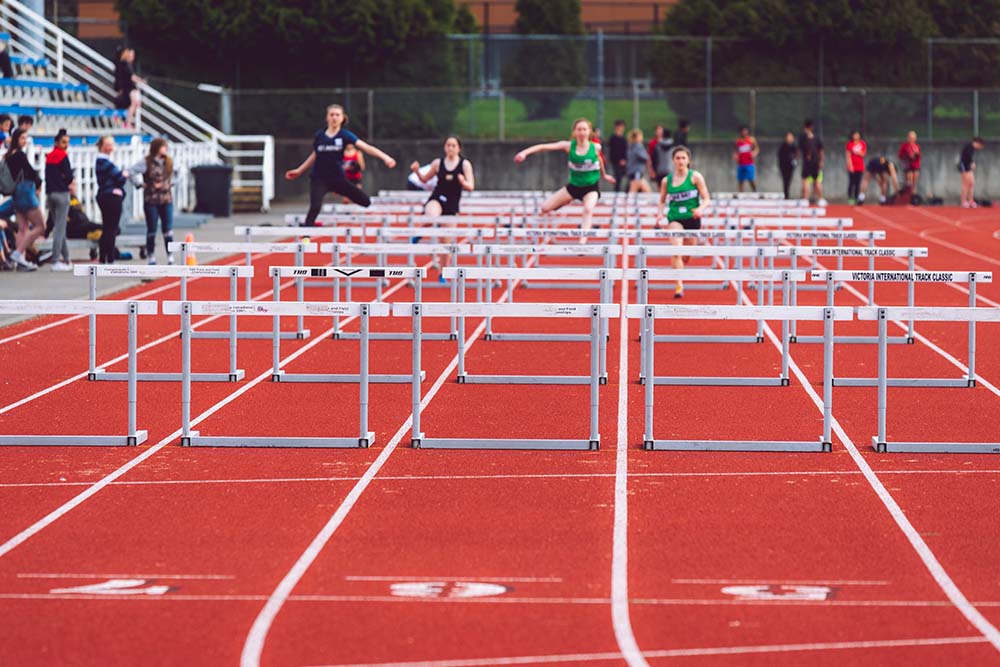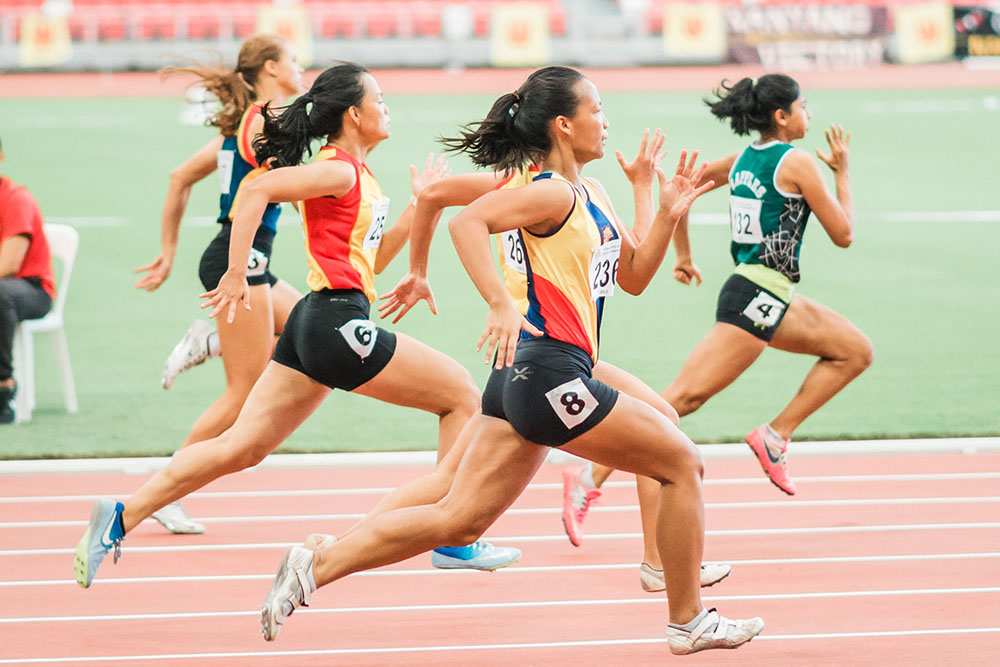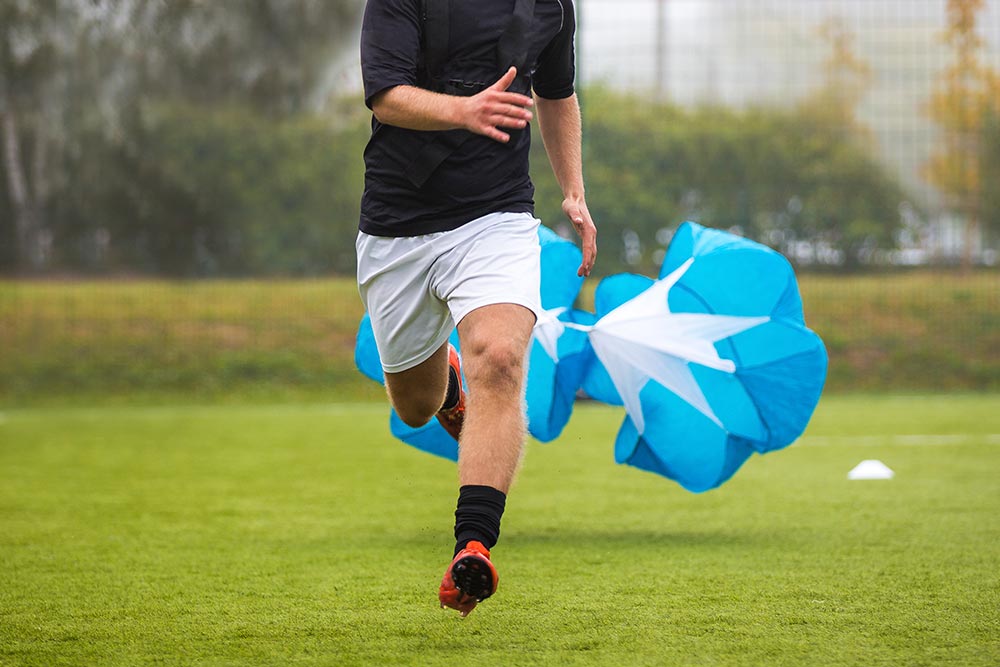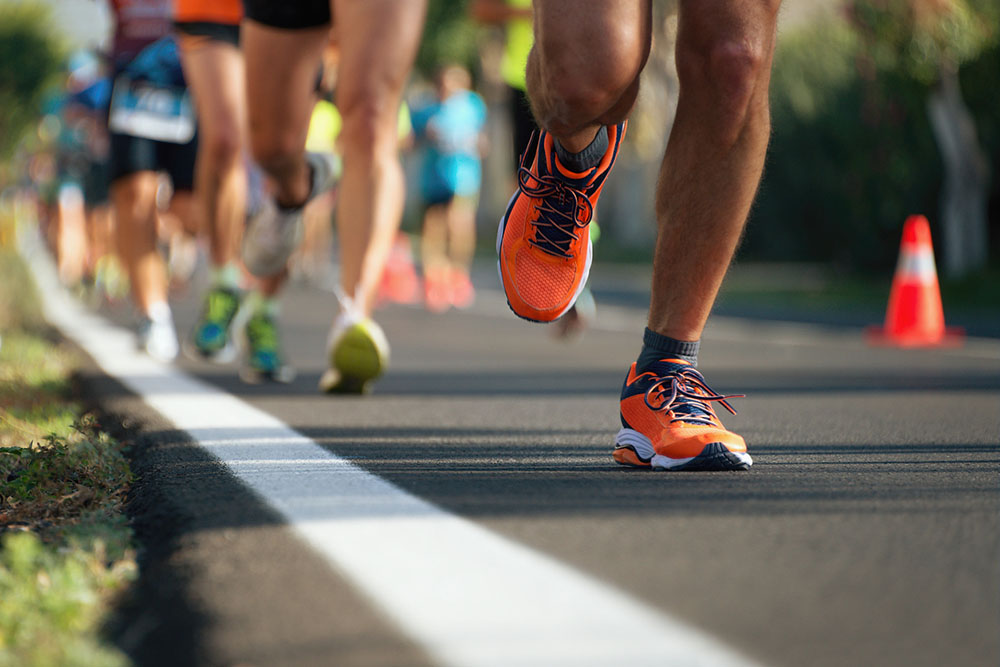So You Want To Be A Sprinter? – Part 1

Evan Stevens
Part 1 : Welcome to Speed
So you want to be a sprinter; be prepared to work at it.
While all humans are born with innate ability to “sprint” (due to biological fight or flight responses), the ranges of ability vary greatly. Some people are destined for Olympic and world championship greatness. Some will never achieve more than the glory of still being able to outpace their young children down the length of their block, or their backyard. But for those of you who are interested in the endeavour of sprint improvement, this is a great place to start.
Sprinting is a very technical event. Like other speed power events, like throws and jumps, sprinting is just as much about the technical and mechanical teachings of the body as it is about running. Distance runners look at the sprinters during practice and see them standing around, wondering what the heck they are doing.
Coming from a distance background myself, a sprint practice was always something foreign to me; why are we standing around for so long? Why are we doing hurdle drills if no one runs the hurdles? Vertical forces? No one said I needed to know physics to run fast. But as we dive into the world of sprinting we start to see just how multifaceted and important all these little things are to running fast. You can’t skimp out on one aspect of good sprinting as it is tied to a bunch of other ones as well.
The Finer Details That Make A Good Sprinter
If you came here looking for just a straightforward training program skip ahead to Part 5 (coming soon), but if you are wondering about the finer details that come together to make a good sprinter, read on.
First and foremost, I want to make a disclaimer that training programs should be athlete specific. Sure you can grab a training program off the internet or in a book and away you go. And most of them are going to work pretty well. Coaches often draw up workouts for the sprint group as opposed to the individual. But we are all different; we all adjust differently to workloads, we all need to work on specific things be it our arm swing, our push off, our snap back, starts, etc. Some of us need to work on turnover, some of us need to work on power. And what happens when the worst happens – an injury?
Training programs are a great start but having an actual coach to walk and guide us through each workout and trial is where you want to get to. If training programs are the guideline, coaches are the guide.
Running Dynamics
Technique is king in sprinting. You could have the ability to run faster than Usain Bolt himself but if you are all over the place and putting energy in directions that won’t help you move along the track, the only place you’ll be going fast is nowhere.
Sprint form can be broken down a number of different ways; you could break it into the start, the acceleration phase, the hold phase (or top speed phase) and the finish. You could break it into each stride individually, the number of strides out of the blocks, and the interaction of foot falls, power generation from the hips, ground reaction forces, stride length and frequency and so on.
All are important aspects of good sprinting but they are all taught differently by different people or with different philosophies. This article attempts to describe all the facets of proper running, good form, and overall running dynamics.
Some highlights of proper form:
- Proper posture
- Snappy legs – push/pull stride
- Power comes from the hips
- Stride length/frequency/flight time – ground contact time and foot height
- Force interaction – vertical and horizontal force interaction
These are just broad highlights that we will go more in depth with throughout part one of this series on sprinting.
But where do we start?
Because all of these things come together to make us run faster it is difficult to start in one place without having some knowledge of the others. I think, however, to better understand sprinting we need to understand the physics of running fast.
The Physics Of Running Fast
Running fast can’t truly be quantified as an equation. The closest we have to something that described fast running came in 2000 in the Journal of Applied Human Physiology. A study titled “Faster Top Running Speeds Are Achieved with Greater Ground Forces Not More Rapid Leg Movements” by Weyland et al. showed just what the title of their article says – that sprinting fast is due to forces applied to the ground, not so much on how fast the foot is repositioned.
They described their findings as such:
V = fstepFavg / WbLc
Where V = Velocity(m/s), fstep = stride frequency, Favg = average force applied to the ground (vertical force), Wb = body weight, and Lc = contact length (ground contact time)
This led to the conclusion that sprinting was reliant on vertical force and faster sprinting meant more vertical force applied. However, later studies have since proven that to be false. It is in fact due to the interaction of both horizontal and minimal vertical forces that result in faster running.
A 2011 study in the Journal of Medicine and Science in Sport Exercise determined that it was the way in which force is applied that leads to faster running. Rather than total force applied, faster running was determined by the vector in which force is applied – a combination of mostly horizontal and some vertical force.
The major finding was that a small mass + large force + right directional vector (direction of applied force) = faster run times.
Vertical And Horizontal Forces
Sprinting comes from the combination of vertical and horizontal forces. Vertical displacement is key to allow for maximum air time and snappier knee drives which helps maintain momentum. Horizontal force applies the direction that you want to actually travel in (along the track). By minimizing horizontal breaking forces and maximizing horizontal propulsion forces we get along the track much more quickly. What this means is we are tall as we run, landing with our feet under us as opposed to in front of us (minimizing the breaking force), with a slight lean forward to keep our legs pushing back as opposed to up (more horizontal force, less vertical).
Stride Length And Ground Contact Time
It is this relationship between horizontal and vertical forces that we truly start to appreciate stride length and ground contact time.
To understand this we need to think of our legs as swinging inverted pendulum springs. Force down and back, spring loads, bounce up, knee drive forward, pendulum swings, drive down again, and repeat.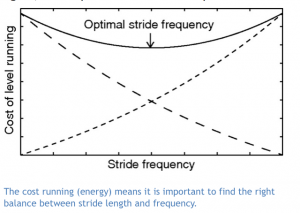 The relationship between the ground contact time and the elastic ability of our legs to return to a prone position (described as a push pull stride) is what makes up stride frequency. Stride frequency, more so than any other aspect of sprinting, seems to be what separates the best sprinters. Top end sprinters have similar flight times or flight phases; what separates them is their ground contact time, the transition between landing and taking off (support phase transition to propulsion phase). It is in that landing phase, or support phase, where differences in top end speed is often decided. The longer the support phase, the larger the increase in the breaking force. Force is going down and forward instead of up and back. Using Newtonian physics, we know that for every action there is an equal and opposite reaction. Thus, an action forward causes and action back – the break.
The relationship between the ground contact time and the elastic ability of our legs to return to a prone position (described as a push pull stride) is what makes up stride frequency. Stride frequency, more so than any other aspect of sprinting, seems to be what separates the best sprinters. Top end sprinters have similar flight times or flight phases; what separates them is their ground contact time, the transition between landing and taking off (support phase transition to propulsion phase). It is in that landing phase, or support phase, where differences in top end speed is often decided. The longer the support phase, the larger the increase in the breaking force. Force is going down and forward instead of up and back. Using Newtonian physics, we know that for every action there is an equal and opposite reaction. Thus, an action forward causes and action back – the break.
While jumpers will often use a bit of a break to gain some leverage in height, sprinters would do well to avoid applying the breaks mid stride.
Proper Form
To avoid breaking forces we go back to thinking of proper form. Your foot needs to land under your body, not in front. If you are landing on your toes, you are golden. Don’t land on your heels – heel striking is indicative of over striding and in both distance and especially sprinting, it causes a huge breaking force. We want to use your swinging spring (your legs) and “paw” at the ground – a snappy leg motion. Let your foot remain dorsiflexed so as to load the spring, which is made up of the muscle and ligaments in through your foot, ankle, and calves.
A 1996 study out of Harvard published in the Journal of Biomechanics found that the stiffer the spring (how loaded it was) the higher the stride frequency of the runner. So fast swinging spring + low ground contact time + high flight time = faster running. It’s not the fastest running, as we still have to consider applied directional forces (horizontal and vertical), but it is where a lot of changes to sprint speed happen.
Going into the support phase it is important to land under your centre of mass so the spring can be optimally loaded for the flight phase. This comes full circle to create the snappy leg motion and the push/pull stride mentality we want of driving your knees up and down and not letting gravity do all the work of force generation.
It’s All In The Hips
To get a proper push/pull stride going however, we need to look at where all the power is coming from – the hips.
Studies dating back over 30 years show that the difference between championship sprinters and “pretty good” sprinters is their ability to move through their hip. That is – top end sprinters are able to extend their hip more through their drive than the other guys. This movement through the hip causes more power applied to a shorter amount of ground contact time, which leads to faster running.
While hip extension is not the direct cause of fast running (it is more a result of powerful strides from the start), good hip extension is a key component to the maintenance of speed as it causes the body to travel over the landing foot very quickly. When the foot lands under the body and the hip is able to extend, power is placed in a short amount of time and speed is maintained better going down the track.
This information is all published in 1981 in the British Journal of Sports Medicine in an article titled “Biomechanical analysis of Sprinting: Decathletes versus Champions. The study pitted 16 championship decathletes against three world class champion sprinters, having each run a 100m race. Cameras at the 70m mark filmed each athlete as they ran by and the researchers were able to measure each athlete’s body angles. The world class sprinters all had a longer stride length at greater frequency, a smaller thigh angle at ground contact time but larger thigh angles through the flight phase (meaning greater hip extension and legs already being placed back down under the body while next stride already driving) leading to faster turn over, and larger trunk angle (angle through the body and trail leg) this means the trail leg is still fully extending off the ground for more power as the next stride is reaching its apex, or optimal knee drive).
Stride Length
Proper hip extension and leg placement improve stride length and frequency and increase flight times, all of which improve sprint performance.
One of my favourite examples of the relationship between stride length and frequency happened this past summer at the 2016 Rio Olympic Games. Sure, we can look at Usain Bolt and Andre De Grasse all we want, comparing the six foot five Jamaican to the five foot nine Canadian, the way that De Grasse’s right arm is outstretched to compensate for torsional forces in his left leg (keep reading for a discussion on arm swing), or how his smaller frame is able to conserve velocity at a rate faster than the longer frame of Bolts, but the 400m this past summer was far and away the greatest race to pick apart in terms of mechanical demonstration. For those out of the loop the 17 year old 400m world record was broken this past summer by the superb South African Wayde Van Niekerk. Van Niekerk broke Michael Johnson’s 17-year-old record of 43.18 in a world record time of 43.03, doing so out of lane eight, the lane furthest to the outside. Most 400m runners want to be in the middle of the track as it gives them an idea of who is around them. The inside lane, lane one, is very tight whereas the outside lane forces you to run blind until pretty much the last corner due to the staggered lane start. However, Lane 8 offers one advantage that the other lanes do not – it is the “straightest;” lane 8 has long corners allowing for more power generation in a single direction than having to navigate the tighter corners of the inner lanes. This allows for a longer, more powerful stride. And when comparing Van Niekerk’s performance to Johnson’s we can see just how important stride length and frequency are in relation to each other and to overall performance.
| Van Niekerk | Johnson | |
| Height | 1.83 | 1.85 |
| Avg. Strides/Second | 3.79 | 4.18 |
| Avg. Stride Length (m) | 2.45 | 2.22 |
| Stride/Height Ratio | 1.34 | 1.20 |
| Avg. Split/100m | 10.75 | 10.8 |
| Avg. Speed (m/s) | 9.296 | 9.264 |
What we see from this is that Van Niekerk has a very long stride considering his height. He and Johnson are very close in height (a mere two centimeter difference) yet he demonstrated the importance of stride length and frequency working in tandem. Johnson relied so much on frequency that he ended up shortening his stride and his performance suffered.
Another way to look at just how impressive Van Niekerk’s performance was is to consider his second 100m. He went through his second 100m in 9.78 seconds with a stride length of 2.63m. 2.63 meters is a stride length that many 100m specialists cannot match. Usain Bolt’s longest recorded stride length was 2.85 when he set the 9.58 second 100m world record in 2009. It is difficult to say whether the performance would translate to an inner lane, given the competitive edge when being able to see and chase your competitors, but we have to consider that lane 8 also offers the most unidirectional force application while running.
Fast running is only possible when there is an equal combination of stride frequency and stride length when force is applied in the correct direction.
You can see a “side by side” difference of the races on YouTube here (excuse the intro soundtrack).
Part 2 Coming Soon…
Related Video:
You Might Like:


